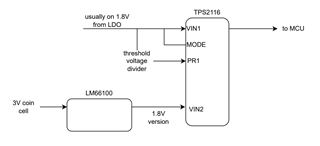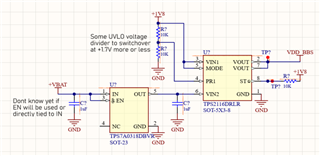Other Parts Discussed in Thread: LM66100, , TPS7A03
Tool/software:
Hello everyone,
I am currently designing a battery backed supply for a MCU. There is a primary voltage source which supplies power to the MCU in normal operation. Once it falls, a coin cell (240 mAh, 3V) powers the MCU in a low power mode. The thing is that the coin cell voltage can't be directly applied to the MCU because the max voltage of MCU power pin is 1.9V. Of course reverse current blocking is a must in this circuit. In order to achieve this design requirement, I have designed the following (it is just an idea):

So, in normal operation the usually on LDO powers the MCU because of the MODE pin. My question come after having read the following post: [FAQ] TPS2117: Why isn’t my Power Mux blocking reverse current/voltage? - Power management forum - Power management - TI E2E support forums
It says if no pull down circuit is available in VINx pins VOUT may pull VINx to its voltage. This is no problem for VIN1 as there is already a voltage divider connected to it. But I don't want to connect a pull down resistor to VIN2 as it will consume the coin cell when it powers the MCU. I am worried if this may damage the LM66100 IC itself.
I have noticed that there is a version of LM66100 with active discharge, that is actived when the IC is not enabled or UVLO condition happens.
Is it the P version of LM66100 enough to avoid backpowering or unwanted current or will the version without this feature work anyway? Is necessary to shutdown the LM66100 to active discharge happen or is this also available when the EN is H (imagine that the Iq current is tolerable and don't want extra components to drive the EN pin in order to achive the shutdown current).
Of course if more suitable components are available for this case, please let me know.
Please correct me if there is a misunderstanding in my post.
Best regards,
Gorka.


